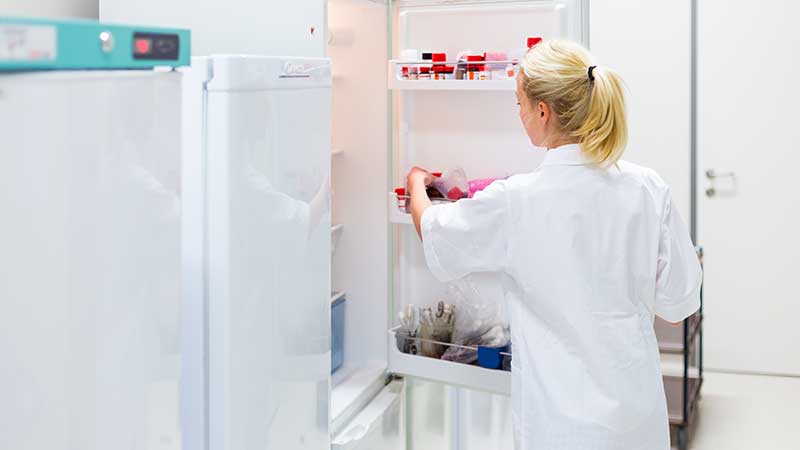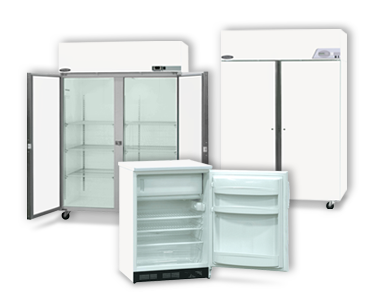
Laboratory Refrigerator Selection Criteria
A laboratory refrigerator or freezer plays a critical role in healthcare facilities, universities, pharmaceutical and medical device manufacturing, and law enforcement. Vaccines, pharmaceuticals, blood samples, plasma, biological specimens and other temperature-sensitive products should not be stored in residential and commercial units.
Proper storage of temperature-sensitive products is governed by organizations such as the Food and Drug Administration and the Centers for Disease Control and Prevention. Pharmaceutical and medical device manufacturers provide recommended storage temperatures for their products.
Why Laboratory Refrigerator Systems are Critical
- Improper storage of vaccines results in loss of potency and the expense of re-vaccination.
- Storing valuable or irreplaceable biological specimens is another example where proper temperature control is critical.
- Replacement costs and potential penalties due to improper storage justify investments in scientific laboratory refrigerators and freezers.
This post covers criteria to consider when specifying your laboratory refrigeration equipment.
Lab Refrigerator and Freezer Categories
Let’s start with temperature capability.
A laboratory refrigerator will typically operate from 1⁰C to 10⁰C.
While most Lab freezers usually operate from -10⁰C to -25⁰C there are exceptions based on models. Low-temperature freezers are available for temperatures to – 25⁰, -30⁰ and -40⁰C.
Ultra-low temperature freezers can be set from -40⁰ to -86⁰C. Applications include forensic labs for long-term evidence storage, and establishing performance specs for parts used in extreme environments. More details are found in our post on ultra-low temperature freezers.
A suggestion: If you are buying a laboratory freezer choose one that delivers the temperature you need. The lower the temperature the more power required.
Five Selection Guidelines for Laboratory Refrigerators and Freezers
1. Storage Capacity
Calculate the size of unit you’ll need. A larger unit will cost more and takes up valuable space.
As an example, the CDC suggests keeping a 60-day supply of vaccines on hand and ordering replacement stock on a 30-day cycle while keeping an eye on expiration dates.
Several configuration options are described later in this post to help you to determine the size of your unit.
2. Temperature Recording and Alarming
As noted earlier, the contents of your laboratory refrigerator or freezer can represent a sizeable investment. Temperature excursions due to a power outage or refrigeration system malfunction can result in losses.
That’s why your unit should be equipped with a temperature recording and alarming system.
A scientific laboratory refrigerator or freezer offered by Tovatech is equipped with audio and visual temperature recording and alarming systems.
Units not so equipped can be fitted with optional digital thermometer alarms. These consist of an internal sensor connected by wire passing over the door gasket or through sensor access ports to an external control and display module.
Another option is a USB temperature data logger with built-in alarms. These automatically record interior temperatures at user-programmable intervals using NIST traceable probes. To read the results, simply plug the USB flash drive into a computer and transfer data to a PC for review and archiving.
Despite these steps, the CDC recommends twice daily manual checking and recording the temperatureof your unit. This provides a staff alert should the recording and alarming system malfunction.
3. Manual and Auto Defrost Laboratory Refrigerators and Freezers
There are important distinctions between manual and auto defrost units.
- Auto-defrost units are generally favored by laboratories and pharmacies. Typically, models have fans that circulate chilled air throughout the unit to create a uniform internal temperature. Some models allow users to control the frequency and duration of the defrost cycle. Tip: Filling the unit with product or water bottles helps reduce temperature fluctuations due to compressor cycling and door openings.
- Manual-defrost scientific refrigerators cool by circulating refrigerant through tubing in the walls. The internal temperature differential causes the cold air to circulate without the use of fans. These units are favored for applications such as experiments in open containers.
- Auto-defrost scientific freezers are preferred by most labs for convenience. They are self-maintaining and don’t require the availability of a second freezer during defrost cycles. Because defrosting is accomplished by an electric heater, there is a temperature fluctuation to take into account. Some auto-defrost freezers allow users to control the defrost cycle.
- Manual-defrost scientific freezers work on the same principal as manual-defrost refrigerators. Ice buildup on interior walls and on the condenser must be removed on a planned basis that includes providing alternative freezer space for the contents during the defrosting operations.
We invite you to view our video on scientific refrigeration for more info.
4. Combination Laboratory Refrigerator and Freezer
As a general rule stand-alone units will maintain better temperature control than refrigerator/freezers with a single condenser. If space limitations dictate and there is a need to provide both refrigeration and freezing capability, there are combination scientific refrigerator-freezer units.
An option for storing less temperature-sensitive products is a lab freezer/refrigerator with a single compressor serving both compartments. The two compartments have separate external doors and may have separate temperature controls. Because cold air from the freezer compartment flows via a vent into the refrigerator compartment the temperatures of the two compartments are not completely independent.
When space is tight, an under counter or countertop refrigerator or freezer may be your only choice.
5. Siting Your Laboratory Refrigerator or Freezer
Here are considerations to keep in mind when purchasing scientific refrigerators and freezers:
- Locating the unit. Provide sufficient space with proximity to a power outlet – dedicated is preferable; extension cords are not recommended.
- Under counter vs. freestanding units. Built-in under-counter units do not require space at the sides and back because they are vented from the front. Free standing units generally require space at the sides and top for air circulation.
- Check side, top and rear clearances requirements for full size units. Some designs, for example, require a few inches while other can be snugged against side cabinets and rear walls.
- Will the under counter lab freezer or refrigerator fit in existing or planned casework? If so allow space for the equipment to function properly and space for the unit to be moved for servicing.
- Local environment. Avoid placing refrigerators and freezers near heating ducts or in areas of direct sunlight.
Browse our broad range of upright, countertop and under counter laboratory refrigerators and freezers.
Special Feature Laboratory Refrigerator or Freezer
Flammable and/or explosion-proof units may be called for to address serious safety issues. Units for flammable materials storage are designed so that volatile substances cannot be ignited by an internal stray spark such as from a compressor or lighting.
If the atmosphere in the lab itself is volatile a hazardous location unit must be specified.
Check our post on specifying flammable and explosion proof refrigerators for more on this topic.
Questions? Contact Tovatech
We hope this information is helpful when specifying laboratory refrigerators and freezers. For additional information and recommendations please contact Tovatech’s scientific refrigerator and freezer professionals.
———-

